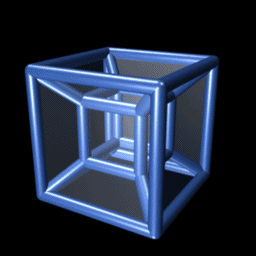Visualizing
Higher Dimensions
Visualizing
Higher Dimensions

Activities
Higher Dimensional Activities:
1. Find out what a tesseract (aka a hypercube) is. You may want to consult Dane Camp’s wonderful article “Escape to a New Dimension” (Camp, 2006) which complements the building and slicing we have used here.
2. Build a dimensional ladder of cubes, beginning with a point and ending at the projected image of a hypercube as follows:
a) Connect two (0-dimensional) points to make a 1-dimensional line.
b) Connect two (1-dimensional) lines to make a 2-dimensional square.
c) Connect two (2-dimensional) squares to make a projection of a 3-dimensional cube. (The typical projection is called a Necker Cube.)
d) Connect two (3-dimensional Necker) cubes to make a projection of a 4-dimensional hypercube.
3.In activity 2 you constructed four rungs on a dimensional ladder. Can you continue this process? If so, how far?
4.Thomas Banchoff’s classic movie of a rotating hypercube has been replaced by interactive Internet scripts which allow users to “play” in the fourth dimension. Experiment with some of these scripts, including:
http://www.dynamicgeometry.com/javasketchpad/gallery/pages/hypercube.php .
5. Describe how CAVEs and other contemporary technology might help us in visualizing objects in higher dimensions.
Abbott’s Flatland was a call for us to move beyond the prejudices of our own dimension. Slicing and building allow us to move up and down the complete dimensional ladder, not just through the single cycle 2D -- 3D.
Much more on this topic is available in Chapter 4 “A Ladder to the Higher Dimensions” in ”Discovering the Art of Mathematics: Geometry,” available online at
Created by Jason Hise with Maya and Macromedia Fireworks. A 3D projection of an 8-cell performing a simple rotation about a plane which bisects the figure from front-left to back-right and top to bottom. From Wikipedia.
Copyright 2011 Julian Fleron and Volker Ecke.